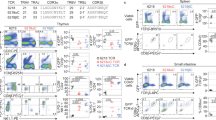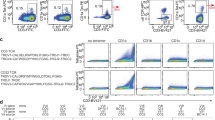Abstract
T cells initiate many immune responses through the interaction of their T-cell antigen receptors (TCR) with antigenic peptides bound to major histocompatibility complex (MHC) molecules. This interaction sends a biochemical signal into the T cell by a mechanism that is not clearly understood. We have used quasi-elastic light scattering (QELS) to show that, in the presence of MHC molecules bound to a full agonist peptide, TCR/peptide–MHC complexes oligomerize in solution to form supramolecular structures at concentrations near the dissociation constant of the binding reaction. The size of the oligomers is concentration dependent and is calculated to contain two to six ternary complexes for the concentrations tested here. This effect is specific as neither molecule forms oligomers by itself, nor were oligomers observed unless the correct peptide was bound to the MHC. These results provide direct evidence for models of T-cell signalling based on the specific assembly of multiple TCR/peptide-MHC complexes1,2,3,4 in which the degree of assembly determines the extent and qualitative nature of the transduced signal5. They may also explain how T cells maintain sensitivity to antigens present in only low abundance on the antigen-presenting cell.
This is a preview of subscription content, access via your institution
Access options
Subscribe to this journal
Receive 51 print issues and online access
$199.00 per year
only $3.90 per issue
Buy this article
- Purchase on Springer Link
- Instant access to full article PDF
Prices may be subject to local taxes which are calculated during checkout



Similar content being viewed by others
References
Symer, D. E., Dintzis, R. Z., Ciamond, D. J. & Dintzis, H. M. Inhibition or activation of human T cell receptor transfectants is controlled by defined, soluble antigen arrays. J. Exp. Med. 176, 1421–1430 (1992).
Brown, J. H. et al. Three-dimensional structure of the human class II histocompatibility antigen HLA-DR1. Nature 364, 33–39 (1993).
Sette, A. et al. Antigen analogs/MHC complexes as specific T cell receptor antagonists. Annu. Rev. Immunol. 12, 413–431 (1994).
Takahama, Y., Suzuki, H., Katz, K. S., Grusby, M. J. & Singer, A. Positive selection of CD4+ T cells by TCR ligation without aggregation even in the absence of MHC. Nature 371, 67–70 (1994).
McKeithan, T. W. Kinetic proofreading in T-cell receptor signal transduction. Proc. Natl. Acad. Sci. USA 92, 5042–5046 (1995).
Matsui, K., Boniface, J. J., Steffner, P., Reay, P. A. & Davis, M. M. Kinetics of T-cell receptor binding to peptide/I-Ek complexes: correlation of the dissociation rate with T-cell responsiveness. Proc. Natl. Acad. Sci. USA 91, 12862–12866 (1994).
Lyons, D. et al. ATCR binds to antagonist ligands with lower affinities and faster dissociation rates than to agonists. Immunity 5, 53–61 (1996).
Fields, B. A. et al. Crystal structure of the Vα domain of a T cell antigen receptor. Science 270, 1821–1824 (1995).
Heldin, C.-H. Dimerization of cell surface receptors in signal transduction. Cell 80, 200–223 (1995).
Kupfer, A. & Singer, S. J. Cell biology of cytotoxic and helper T cell functions. Annu. Rev. Immunol. 7, 309–337 (1989).
Garcia, K. C. et al. CD8 enhances formation of stable T-cell receptor/MHC class I molecule complexes. Nature 384, 577–581 (1996).
Ghosh, P., Amaya, M., Mellins, E. & Wiley, D. C. The structure of an intermediate in class II MHC maturation: CLIP bound to HLA-DR3. Nature 378, 457–462 (1995).
Fremont, D. H., Hendrickson, W. A., Marrack, P. & Kappler, J. Structures of an MHC class II molecule with covalently bound single peptides. Science 272, 1001–1004 (1996).
Garcia, K. C. et al. An αβ T cell receptor structure at 2.5Å and its orientation in the TCR-MHC complex. Science 274, 209–219 (1996).
Garboczi, D. N. et al. Structure of the complex between human T-cell receptor, viral peptide and HLA-A2. Nature 384, 134–141 (1996).
Rabinowitz, J. D., Beeson, C., Lyons, D. S., Davis, M. M. & McConnell, H. M. Kinetic discrimination in T-cell activation. Proc. Natl Acad. Sci. USA 93, 1401–1405 (1996).
Alam, S. M. et al. T-cell-receptor affinity and thymocyte positive selection. Nature 381, 616–620 (1996).
Davis, M. M. T-cell receptors: Serial engagement proposed. Nature 375, 104 (1995).
Germain, R. N. Seeing double. Curr. Biol. 3, 586–589 (1993).
Lin, A. Y. et al. Expression of T cell antigen receptor heterodimers in a lipid-linked form. Science 249, 677–679 (1990).
Provencher, S. CONTIN: A general purpose constrained regularization program for inverting noisy linear algebraic and integral equations. Comput. Phys. Commun. 27, 229–242 (1982).
Wettstein, D. A., Boniface, J. J., Reay, P. A., Schild, H. & Davis, M. M. Expression of a class II histocompatibility complex (MHC) heterodimer in a lipid-linked form with enhanced peptide/soluble MHC complex formation at low pH. J. Exp. Med. 174, 219–228 (1991).
Kirkwood, J. G. The general theory of reversible processes in solutions of macromolecules. J. Polym. Sci. 12, 1–14 (1954).
Bloomfield, V., Dalton, W. O. & Van Holde, K. E. Frictional coefficients of multisubunit structures, I: Theory. Biopolymers 5, 135–148 (1967).
Acknowledgements
All authors contributed equally to this work. We thank L. Nguyen and S. Erickson-Ybarra for help in the preparation of I-Ek and 2B4, and I. Rousso for help in sample preparation for the QELS experiments. D.S.L. is supported by a Howard Hughes Medical Institute predoctoral fellowship. J.J.B. was supported by an NIH training grant and a fellowship from the Irvington Institute for Medical Research. This work was supported by grants to M.M.D. from the NIH and the Howard Hughes Medical Institute.
Author information
Authors and Affiliations
Corresponding author
Rights and permissions
About this article
Cite this article
Reich, Z., Boniface, J., Lyons, D. et al. Ligand-specific oligomerization of T-cell receptor molecules. Nature 387, 617–620 (1997). https://doi.org/10.1038/42500
Received:
Accepted:
Issue Date:
DOI: https://doi.org/10.1038/42500
This article is cited by
-
TCR microclusters form spatially segregated domains and sequentially assemble in calcium-dependent kinetic steps
Nature Communications (2019)
-
Monomeric TCRs drive T cell antigen recognition
Nature Immunology (2018)
-
Actin polymerization‐dependent activation of Cas‐L promotes immunological synapse stability
Immunology & Cell Biology (2016)
-
Mechanisms for T cell receptor triggering
Nature Reviews Immunology (2011)
-
Spatial organization and signal transduction at intercellular junctions
Nature Reviews Molecular Cell Biology (2010)
Comments
By submitting a comment you agree to abide by our Terms and Community Guidelines. If you find something abusive or that does not comply with our terms or guidelines please flag it as inappropriate.



